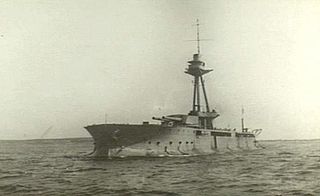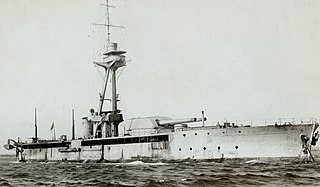
The M29 class comprised five monitors of the Royal Navy, all built and launched during 1915.

HMS Raglan was a First World War Royal Navy Abercrombie-class monitor, which was sunk during the Battle of Imbros in January 1918.

The Erebus class of warships was a class of 20th century Royal Navy monitors armed with a main battery of two 15-inch /42 Mk 1 guns in a single turret. It consisted of two vessels, Erebus and Terror, named after the two ships lost in the Franklin Expedition. Both were launched in 1916 and saw active service in World War I off the Belgian coast. After being placed in reserve between the wars, they served in World War II, with Terror being lost in 1941 and Erebus surviving to be scrapped in 1946.

The Marshal Ney class was a class of monitor built for the Royal Navy during the First World War.

HMS Abercrombie was a First World War Royal Navy Abercrombie-class monitor.

HMS Marshal Ney was the lead ship of her class of two monitors built for the Royal Navy during the First World War. Laid down as M13, she was renamed after the French field marshal of the Napoleonic Wars Michel Ney. After service in the First World War, she became a depot ship and then an accommodation ship. Between 1922 and 1947, she was renamed three times, becoming successively Vivid, Drake and Alaunia II. She was scrapped in 1957.
HMS Prince Eugene was one of eight Lord Clive-class monitors built for the Royal Navy in 1915 to conduct shore bombardments during the First World War. The ship was assigned to the Dover Patrol for the duration of the war and provided cover for the Inshore Squadron during the First Ostend Raid. She was sold for scrap in 1921.
HMS Sir John Moore was one of eight Lord Clive-class monitors built for the Royal Navy in 1915 to conduct shore bombardments during the First World War. The ship was assigned to the Dover Patrol for the duration of the war and was sold for scrap in 1921.

The Humber-class monitors were three large gunboats under construction for the Brazilian Navy in Britain in 1913. Designed for service on the Amazon River, the ships were of shallow draft and heavy armament and were ideally suited to inshore, riverine and coastal work but unsuitable for service at sea, where their weight and light draft reduced their speed from a projected twelve knots to under four. The class comprised Humber, Mersey and Severn. All three were taken over by the Royal Navy shortly before the outbreak of the First World War and were commissioned as small monitors. All three saw extensive service during the war and were sold in 1919.

HMS Roberts was an Abercrombie-class monitor of the Royal Navy that served in the First World War.
HMS M32 was an M29-class monitor of the Royal Navy.
HMS M28 was a First World War Royal Navy M15-class monitor. She was sunk during the Battle of Imbros in 1918.
HMS M27 was a First World War Royal Navy M15-class monitor. She was also served in the British intervention in Russia in 1919, and was scuttled in the Dvina River on 16 September 1919.
HMS M25 was a First World War Royal Navy M15-class monitor. She was also served in the British intervention in Russia in 1919, and was scuttled in the Dvina River on 16 September 1919.
HMS M19 was a First World War Royal Navy M15-class monitor.
HMS M22 was a First World War Royal Navy M15-class monitor. Later converted to a minelayer and renamed HMS Medea, she was wrecked whilst being towed for breaking up on 2 January 1939.
HMS M23 was a First World War Royal Navy M15-class monitor. After service in the Mediterranean and the Dover Patrol, she was also served in the British intervention in Russia in 1919. Converted to the RNVR drillship Claverhouse in 1922, she served in that capacity at "Leith" until 1958.
HMS M18 was a M15-class monitor built for the Royal Navy during the First World War.

HMS M17 was a First World War Royal Navy M15-class monitor.
HMS M16 was a First World War Royal Navy M15-class monitor.









